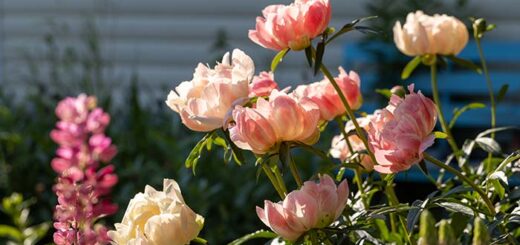Pruning Mistakes That Will Ruin Your Peony
Peonies are cherished for their lush blooms and striking beauty, making them a favorite among gardeners. However, improper pruning can easily turn these magnificent plants into a disappointment. If you’re wondering about the common mistakes that could ruin your peony, you’re in the right place. This guide will highlight the key pruning errors and provide detailed advice to ensure your peonies thrive.
Don’t Trim After Blooming
One of the most common mistakes gardeners make is trimming their peonies immediately after they bloom. Cutting back the plant once the flowers fade might seem logical, but this can harm your peonies.
Why You Should Avoid It
After blooming, peonies need their foliage to gather energy and nutrients for the following year’s growth. Cutting them back too soon deprives the plant of the ability to photosynthesize effectively, which can weaken it and result in fewer blooms the following season.
What to Do Instead
Allow the foliage to remain intact until it turns yellow and withers. This period is crucial for the plant’s health, as it stores energy in its roots. Only trim the dead and yellowing parts in late fall or early winter, ensuring the plant is ready to rest and rejuvenate for the next growing season.

Image Source: Envato Elements
Why Pruning Needs to Wait
Pruning peonies at the wrong time can lead to several issues, including reduced blooming and potential disease problems.
Understanding the Growth Cycle
Peonies have a specific growth cycle that includes a period of active growth, blooming, and dormancy. Pruning too early disrupts this cycle, preventing the plant from completing its natural processes.
Disease Prevention
Pruning at the wrong time can also expose your peonies to diseases. For instance, cutting back healthy foliage too early can leave open wounds susceptible to fungal infections. These infections can spread quickly and cause significant damage to the plant.
When to Prune
Knowing when to prune your peonies is essential to their health and productivity.
Late Fall Pruning
The best time to prune peonies is in late fall, after the first frost. The foliage will have died naturally, and the plant will be ready to go dormant. Pruning at this time helps to clean up the garden and remove any diseased or dead plant material.
Early Spring Touch-Up
You can do a light touch-up in early spring to remove any remaining dead stems or foliage missed in the fall. This helps create a clean environment for new growth and reduces disease risk.
How to Prune
Proper pruning techniques are just as important as timing. Using the right methods ensures that your peonies remain healthy and vigorous.
Tools and Preparation
Use clean, sharp pruning shears to make clean cuts. Sterilize your tools before and after use to prevent the spread of disease. Wear gloves to protect your hands from any sharp edges or thorns.
Pruning Steps
- Remove Dead Stems: Start by cutting away any dead stems at the base of the plant. These are usually brown and brittle.
- Trim Yellowing Foliage: Cut back any yellowing or diseased foliage, ensuring you don’t damage the healthy parts of the plant.
- Shape the Plant: If necessary, shape the plant by trimming any overly long stems that disrupt the desired form.
Types of Peonies
Understanding the different types of peonies can help you tailor your pruning techniques to suit each variety’s needs.
Herbaceous Peonies
These are the most common types, dying back to the ground each winter. They require pruning in late fall to remove all dead foliage and prepare for new growth in the spring.
Tree Peonies
Unlike herbaceous peonies, tree peonies have woody stems that do not die back in winter. They should be pruned lightly to shape and remove dead wood, typically in early spring before new growth starts.
Intersectional (Itoh) Peonies
Itoh peonies are a hybrid of herbaceous and tree peonies with a unique growth pattern. They are pruned similarly to herbaceous peonies in late fall, removing dead wood in early spring.
Peonies to Try
Choosing suitable peony varieties can enhance your garden’s beauty and make pruning more manageable.
Festiva Maxima
Festiva Maxima is a classic choice for any garden, known for its large, fragrant white blooms with crimson flecks. Its robust growth makes it relatively easy to care for.
Sarah Bernhardt
Sarah Bernhardt, a favorite for its stunning double-pink flowers, is a reliable bloomer with a lovely fragrance. It’s an excellent choice for cut flowers.
Bartzella
This Itoh peony offers bright yellow blooms with a slight lemon scent. Bartzella is vigorous and disease-resistant, making it a great option for beginners.
Bowl of Beauty
With striking pink outer petals and creamy yellow centers, Bowl of Beauty is a showstopper. It’s easy to grow and provides a long blooming period.
FAQs on Pruning Mistakes That Will Ruin Your Peony
Q: Can pruning peonies too early cause them not to bloom next year?
A: Pruning too early can deprive peonies of essential nutrients needed for next year’s blooms, reducing flowering.
Q: Is it safe to prune peonies during the summer?
A: No, summer pruning can disrupt the plant’s growth cycle and lead to weakened plants and fewer blooms in the following season.
Q: How much of the peony plant should I prune back in the fall?
A: In late fall, prune all dead foliage and stems to ground level, leaving the base intact to protect the plant through winter.
Q: Can I prune peonies when they are wet?
A: Avoid pruning wet peonies, as this can increase the risk of spreading fungal diseases. Wait for dry conditions to prune.
Q: What are the signs that I’ve pruned my peonies too much? A: Over-pruning can result in sparse growth, fewer blooms, and a generally weakened plant appearance in the next growing season.
Q: Should I remove peony seed pods after blooming?
A: Removing seed pods can redirect the plant’s energy towards root development and blooming rather than seed production.
Q: Is it okay to prune peonies in the spring?
A: Light pruning in early spring is okay for removing any remaining dead stems, but avoid heavy pruning as it can affect new growth.
Q: Can improper pruning lead to pest infestations in peonies?
A: Yes, improper pruning can leave wounds susceptible to pests, making the plant more vulnerable to infestations.
Q: How can I avoid damaging the peony’s crown while pruning?
A: Be careful when pruning above the crown, which is where stems meet the roots. Damaging the crown can harm the plant’s growth.
Q: Are there specific diseases associated with improper pruning of peonies?
A: Improper pruning can expose peonies to botrytis blight and other fungal infections, which can spread quickly and damage the plant.
Q: Can pruning tools affect the health of my peonies?
A: Dirty or dull tools can cause ragged cuts and introduce diseases. Always use clean, sharp pruning shears.
Q: How often should I sterilize my pruning tools?
A: Sterilize your pruning tools before and after each use to prevent the spread of diseases between plants.
Conclusion
Pruning peonies correctly is essential for maintaining their health and ensuring a vibrant display of blooms yearly. Avoid common mistakes like trimming too soon after blooming, and always wait until the right time to prune. Use proper techniques and tailor your approach to the peony you’re growing.
References:
Southern Living: Pruning Mistakes That Will Ruin Your Peony


